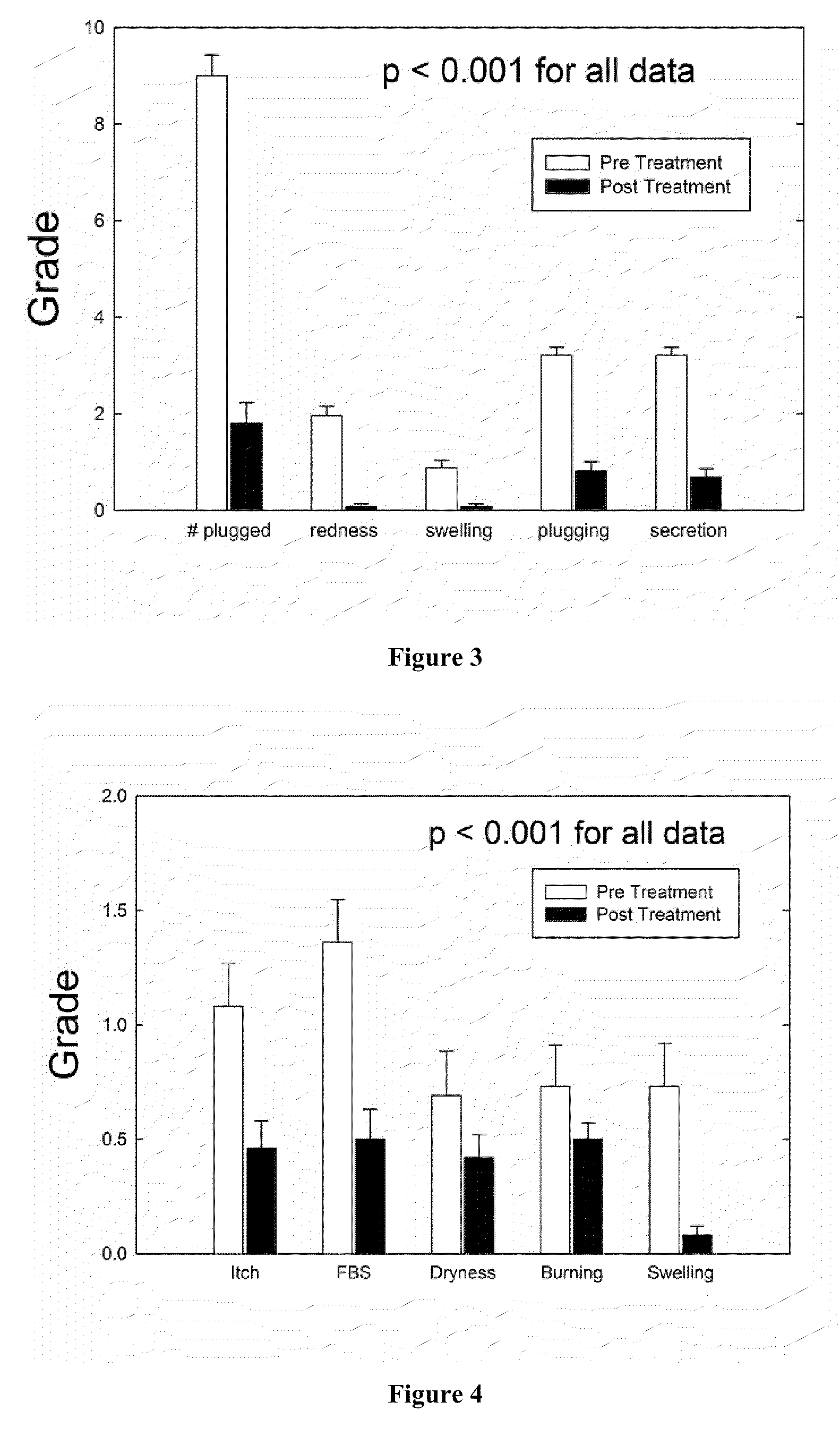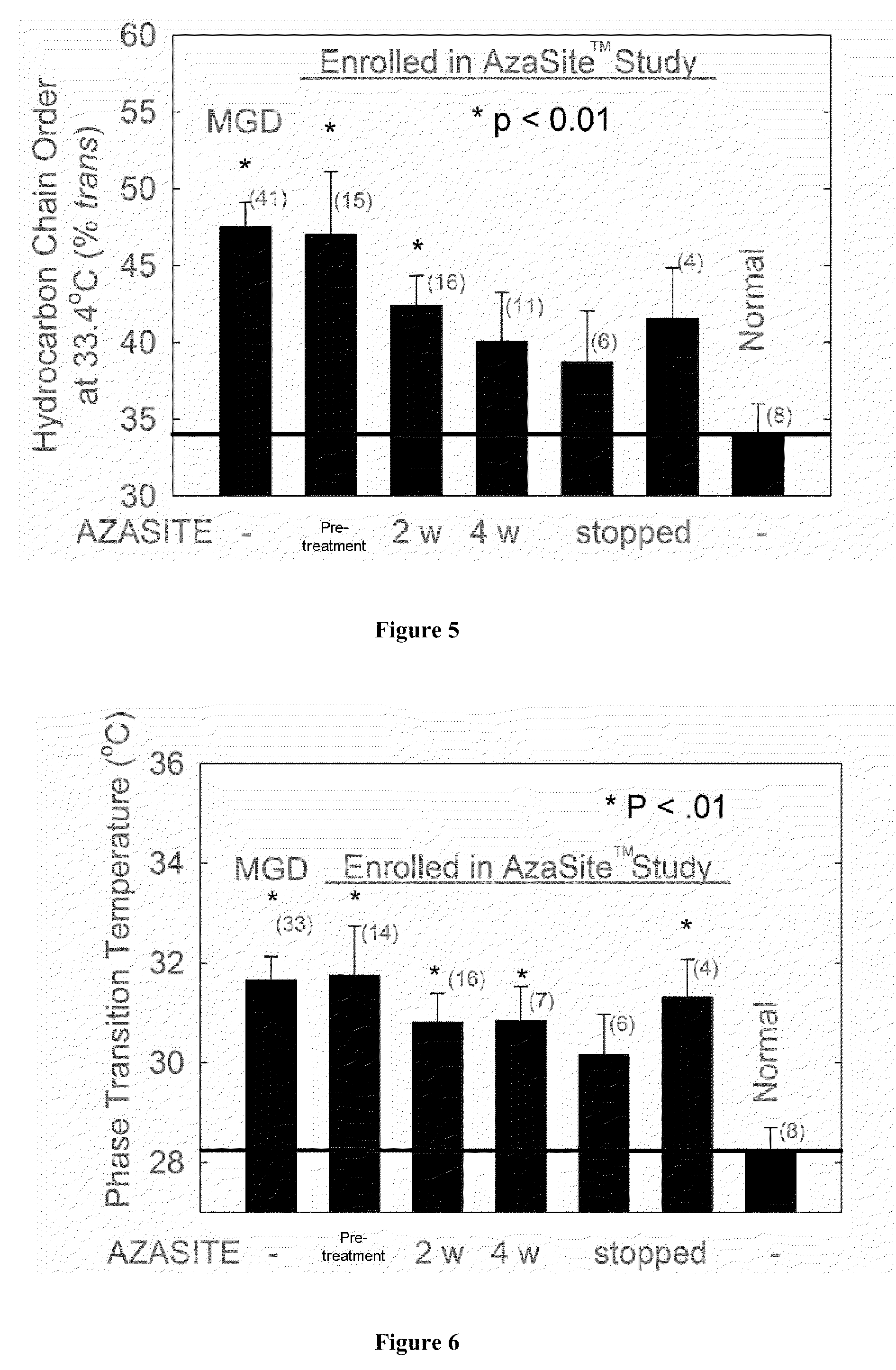Method of treating blepharitis
a blepharitis and blepharitis technology, applied in the field of blepharitis treatment methods, can solve the problems of evaporative dry eye, blepharitis in its mild form is usually undiagnosed and rarely managed, and the thickness or functional integrity decreases, so as to reduce the symptoms and/or clinical signs of blepharitis, and block the secretion of the meibomian gland
- Summary
- Abstract
- Description
- Claims
- Application Information
AI Technical Summary
Benefits of technology
Problems solved by technology
Method used
Image
Examples
example 1
Effect of Azithromycin on Subjects with Posterior Blepharitis
Objectives
[0051]The objective of this study was to compare the efficacy of study drug, AZASITE® (azithromycin ophthalmic solution) 1%, in conjunction with mechanical therapy (warm compress) versus mechanical therapy alone over a two week treatment period on the signs and symptoms of subjects with posterior blepharitis.
Subjects
[0052]Subjects were 18 years of age or older, and had a clinical diagnosis of moderate to severe posterior blepharitis. Subjects did not have suspected ocular infection, lid structural abnormalities, or have presence of inflammation and / or active structural change in the iris or anterior chamber. A total of 21 subjects were enrolled in the study.
Methods
[0053]This was an open-label study. At Visit 1 (Day 1), all subjects were randomized in 1:1 ratio to receive (a) mechanical therapy alone without study drug (Compress group), or (b) drug in combination with mechanical therapy (Combination group), for 14...
example 2
Effect of Azithromycin on Subjects with Chronic Blepharitis
Objectives
[0088]The objective of this study was to compare the safety and efficacy of AZASITE® (azithromycin ophthalmic solution, 1%) in conjunction with mechanical therapy versus mechanical therapy alone without the use of AZASITE® over a 4-week treatment period on signs and symptoms in subjects with chronic blepharitis.
Subjects
[0089]Subjects were 18 years of age or older, and had a clinical diagnosis of moderate to severe chronic blepharitis, with a clinical sign severity score of at least 2 (moderate) on either redness or swelling (or both) of the eyelid margin and on either eyelid debris or plugging of the meibomian gland (or both). Subjects also had a symptom severity score of at least 2 (moderate) on their self-reported “most bothersome” symptom at baseline and a score of at least 2 (moderate) on any other symptom. Subjects did not have suspected ocular infection, lid structural abnormalities, or have presence of infla...
example 3
Modification of Meibomian Gland Lipids by Topical Azithromycin
Objectives
[0127]The objective of this study was to assess the effects of AZASITE® (azithromycin ophthalmic solution, 1%) on the physicochemical properties of the meibomian gland secretions in patients with meibomian gland disease (posterior blepharitis).
Subjects
[0128]Seventeen adult subjects with symptomatic meibomian gland dysfunction unresponsive to lid massage therapy. A total of 17 subjects were enrolled in the study.
Methods
[0129]This was a prospective, open-label, interventional clinical trial using topical azithromycin 1% solution applied once daily for one month of therapy. Clinical examinations were performed at entry, at week 2 and 4 of therapy, and one month following cessation of therapy to evaluate symptoms and signs of MGD. Expression of the meibomian glands was performed at each visit and collected meibum was stored under argon gas in a freezer until spectroscopic analysis. Signs and symptoms were scored on ...
PUM
| Property | Measurement | Unit |
|---|---|---|
| tear break-up time | aaaaa | aaaaa |
| time | aaaaa | aaaaa |
| time | aaaaa | aaaaa |
Abstract
Description
Claims
Application Information
 Login to View More
Login to View More - R&D
- Intellectual Property
- Life Sciences
- Materials
- Tech Scout
- Unparalleled Data Quality
- Higher Quality Content
- 60% Fewer Hallucinations
Browse by: Latest US Patents, China's latest patents, Technical Efficacy Thesaurus, Application Domain, Technology Topic, Popular Technical Reports.
© 2025 PatSnap. All rights reserved.Legal|Privacy policy|Modern Slavery Act Transparency Statement|Sitemap|About US| Contact US: help@patsnap.com



